![]()
![]()
![]()
Use LEFT and RIGHT arrow keys to navigate between flashcards;
Use UP and DOWN arrow keys to flip the card;
H to show hint;
A reads text to speech;
383 Cards in this Set
- Front
- Back
- 3rd side (hint)
|
Metabolism of pancuronium responsible for inadequate recovery |
17-OH pancuronium |
|
|
|
Armitage formula for caudal epidural |
0.5 ml/kg of 0.25% bupivacaine for a lumbosacral block 0.75 ml/kg for inguinal hernia repair 1 ml/kg for a lower thoracic block 1.25 ml/kg for a mid-thoracic block. |
|
|
|
Iontophoresis |
This is a process whereby electrical field is applied to the skin and a small polarised molecule is transferred across various surfaces- skin, eyes, bones etc. Insulin transfer via iontophoresis is difficult as it is a large molecule |
|
|
|
N2O storage pressures |
French blue cylinders (C= 450 L, to G= 9000 L) Gauge pressure: 51 bar at 20 C |
|
|
|
Filling ratio |
Mass of N2O in the cylinder/ Mass of water the cylinder could hold 0.75: temperate regions 0.67: tropical regions |
|
|
|
Critical temperature and critical pressure of N2O |
Critical temperature: 36.5C Critical pressure: 72 bar |
|
|
|
Sevoflurane structure |
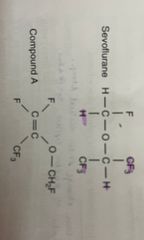
Polyflurinated isopropyl methyl ether |
|
|
|
When Selvi reacts with Lewis acid what does it produce |
Toxic hydrofluric acid(HF) |
|
|
|
Lewis acid |
Any substance that can accept an electron pair Includes metal oxides and H+ |
|
|
|
When sevo reacts with Lewis acid what does it produce |
Toxic hydrofluric acid(HF) Due to reaction at its ether and halogen bonds. Prevention: add 300 ppm of water to sevo during preparation |
|
|
|
Metabolism of sevo |
Cytochrome P4502E1 Products: hexafluroisopropanol and inorganic F(renal toxicity) |
|
|
|
Toxic compound of sevo |
Compound A |
|
|
|
Halothane structure |

Back (Definition) |
|
|
|
Metabolites of halothane |
Oxidative metabolism (via cut P450) Trifluroacetic acid, Br- and Cl- Reductive metabolism: F-, reduced metabolite. Oxidative metabolites are toxic |
|
|
|
Hepatic damage due to halothane |
Halothane hepatitis Fulminant hepatic necrosis D/t trifluroacetyl chloride |
|
|
|
Enflurane structure |

Halogenated ethyl methyl ether Structural isomer of ISOFLURANE |
|
|
|
Special properties of enflurane |
At high concentrations, epileptiform spikes on EEG, 3Hz spikes, consistent with grandmal seizures |
|
|
|
Structure of desflurane |

Fluorinated ethyl methyl ether |
|
|
|
Special properties of des |
Bp: 23.5C, uses Tec 6 vapouriest |
|
|
|
Substance added to halothane for storage |
0.01% thymol Prevents liberation of free bromine |
|
|
|
Xenon a)MAC b) B:G partition coefficient |
a)71% b) 0.14 ( low) |
|
|
|
Production of xenon |
Fractional distillation of air |
|
|
|
Xenon metabolisn |
None. Eliminate directly via the lungs |
|
|
|
Manufacturing of oxygen |
Fractional distillation of air via an O2 concentrator ➡️ zeolite mesh which absorbs N2. |
|
|
|
Storage forms of oxygen |
Gas: black cylinders with white shoulder at 137 bar Liquid: VIE: vacuum insulated vapouriest at 10 bar and -180C |
|
|
|
Physicochemical properties of oxygen |
Boiling point: -182C Critical temp: -119C Critical pressure: 50 bar |
|
|
|
Measurement of oxygen |
Gas mixture: mass spectrometer, paramagnetic analyser, fuel cell Dissolved in blood: Clarke electrode, transcutaneous electrode or pulse oximetry In vitro samples: bench or Co oximetry |
|
|
|
Oxygen toxicity |
D/t Free radicals Pressure> 200 kPa: anxiety, nausea, seizures Retrolental fibroplasia in neonates |
|
|
|
Physicochemical properties of CO2 a) Boiling point b) Critical temperature c) Critical pressure |
a) Boiling point: -78.5 C b) Critical temperature: 31C c) Critical pressure: 73.8 bar |
|
|
|
Racemic mixtures |
All inhalationals except SEVO BUPIVACAINE KETAMINE ATROPINE Racemic EPINEPHRINE |
|
|
|
Which form of ketamine is better |
S(+) ketamine |
|
|
|
Doxazocin |
Alpha adrenergic blocking agent |
|
|
|
Ondensetron acts on which receptors? |
Antagonist at 5 HT3 receptor |
|
|
|
Therapeutic index |
LD50:ED50 |
|
|
|
Drugs with low therapeutic index |
Warfarin Vancomycin Digoxin |
|
|
|
Therapeutic index |
LD50:ED50 For greater safety: Dx should have high therapeutic index Dimensionless |
|
|
|
Dx with high therapeutic index |
Penicillin Ibuprofen |
|
|
|
Treatment for cyanide poisoning |
Dicobalt edetate |
|
|
|
Type A adverse drug reaction |
Predictable and dose dependant Eg: hypotension followed by propofol administration |
|
|
|
Type B reactions |
Idiosyncratic reactions Unpredictable, dose independent and unknown to the pharmacological properties of the drug |
|
|
|
Anaphylactoid reactions |
Non IgE mediated Examples for type B reactions |
|
|
|
Cytochrome P450 inducers |
Phenytoin Carbamazepine Rifampicin Chronic alcohol Barbiturates Cigarette smoking Pc with alc, barbs and smoke |
|
|
|
Classification of drug interaction |
Physicochemical interaction Pharmacodynamic interaction Pharmacokinetic interaction |
|
|
|
Physicochemical interaction |
D/t physical or chemical incompatibility Eh: acidic heparin terminates by strongly basic ptotamine |
|
|
|
Pharmacokinetic interaction |
Effect of co administered drugs on ADME EG: beta blockers reduce CO ➡️ reduce distribution of other drugs to their site of action |
|
|
|
Pharmacodynamic interaction |
Competition for the binding site of an enzyme or receptor |
|
|
|
Types of pharmacodynamic interaction |
Direct: substance A and B compete for the same site on a receptor eg: Flunazenil and BZD. Indirect: substance A is present in one site of the receptor and substance B is unable to bind to another site on same receptor Eg: neostigmine and Ach |
|
|
|
Kinetics of phenytoin |
First order kinetics at low doses and zero order kinetics at high doses |
|
|
|
Zero order kinetics |
Rate of change of plasma drug concentration is constant rather than being dependent on the concentration of drug present |
|
|
|
First order kinetics |
Plasma level of the drug is proportional to the amount of drug present |
|
|
|
Dx crossing the placenta |
All VA induction agents |
|
|
|
Drugs via passive diffusion into the cell |
Iv induction agents Opioids |
|
|
|
Facilitated diffusion |
Glucose Cephalexin Azoles |
|
|
|
Clearance of a drug |
Refers to the rate at which the drug is removed from the plasma Value: ml/min Clearance= Kel x Vd Where Kel: elimination rate constant ⬆️Vd: slow clearance ⬇️ Vd: fast clearance |
|
|
|
Half time (t1/2) of a drug |
Time taken for the drug in the plasma to fall by 50% |
|
|
|
Time constant (tau) |
Time constant: 1/Kel Time taken for the amount of drug in the plasma to fall by 36% if it’s starting value Tau= t1/2/ 0.693 |
|
|
|
Perfusion in drug compartments |
Central compartment is well perfused. Peripheral compartments are connected to the central compartments and are less perfused |
|
|
|
Drug elimination occurs from which compartment |
Central |
|
|
|
Catenary models |
Compartments are linked adjacent to each other rather than central and peripheral |
|
|
|
Context sensitivity |
Time taken for the plasma concentration of a drug to fall to 50% subsequent to the cessation of an infusion. After the steady state plasma conc.has been achieved |
|
|
|
Which drug displays context insensitivity and y? |
Remifentanil as it is metabolised by non specific esterases Alfentanul displays context insensitivity when infused for > 2 hours. |
|
|
|
Schnider pharmacokinetic model |
Calculates the lean body mass of patients Restricts the central compartment preventing overdosing of patients Suitable for elderly |
|
|
|
Chromosome for producing plasma cholinesterase |
Chromosome 3, 10 genotypes |
|
|
|
Patterns of inheritance of plasma cholinesterase genes |
96%: homozygous Eu:Eu 4%: heterozygous- prolongs block upto 20 mins Very small percentage: little or No cholinesterase activity Ea:Ea, Es:Es and Es:Ea |
|
|
|
Dibucaine number |
%ge inhibition of plasma cholinesterase. Normally dibucaine inhibits Eu:Eu by 80% and Ea:Ea by 20% |
|
|
|
Malignant hyperthermia is due to defect in which chromosome |
AD condition Defect in Ryanodine receptor on Chr 19 |
|
|
|
Time needed to reach steady state concentration with respect to half life in first order kinetics |
4-5 half lives Half life x 4= time needed to reach steady state concentration |
|
|
|
Phases of a drug reaction |
Phase 1:oxidation, reduction and hydrolysis. Converts drug to lipophilic form Phase 2: acetylation, sulphonation, methylation and glucironidation Converts drug to water soluble form |
|
|
|
NAT |
N acetyl transferase Enzyme in phase 2 reaction Dugs affected: hydralazine, isoniazid, procainamide, dapsone, sulphasalazine |
|
|
|
How to calculate Vd |
Dose/ concentration of the drug at time zero |
|
|
|
Calorie content of propofol |
1 cal/min |
|
|
|
Propofol metabolism |
40% conjugation to a glucuronude 60%: metabolised to quinol, All metabolites are inactive and excreted in urine |
|
|
|
Action of ketamine at opioid receptors |
Antanalgesic Antagonist at OP 3 ( mu receptor) Agonist at OP1, OP 2 receptors |
|
|
|
Structure of etomidate |
Carboxylated imidazole derivative + an ester 35% v/v propylene glycol Ph: 4.1 |
|
|
|
Etomidate suppresses which enzymes |
11 beta hydroxylase 17 alpha hydroxylase Results in inhibition of cortisol and aldosterone |
|
|
|
Tautomerism |
Dynamic interchange between 2 forms of molecular structure due to change in physical environment. Eg: keto to Emil form |
|
|
|
Pathways for BZD bio transformation |
Hepatic microsomal oxidation ( N dealkylation or aliphatic hydroxylation) Glucuronide conjugation Hydroxylated Metabolites are pharmacologically active |
|
|
|
Metabolites of diazepam |
Notdiazepam Temazepam Oxazepam |
|
|
|
Protein binding of propofol |
98% |
|
|
|
Protein binding of BZD |
70-95% |
|
|
|
N2O production |
Heating of ammonium nitrate to 240C |
|
|
|
B:G partition coefficient |
ISO:1.4 Des : 0.45 N20: 0.47 |
|
|
|
Sevoflurane pharmacokinetics |
Bp: 58C MW: 200 SVP: 21kPa at 20C B:G: 0.69 O:G : 53 Metabolites: 3-5% |
|
|
|
Relation b/W potency and O: G partition coefficient |
Direct |
|
|
|
Relation b/W potency and MAC |
Inversely |
|
|
|
Halothane properties |
Bp: 50C MW: 197 SVP: 32kPa at 20C O:G : 225 Merabolized: 20% |
|
|
|
Physicochemical pptys of inhaled ax |

Back (Definition) |
|
|
|
Systemic concentrations of LA at different sites |
Intercostal >Caudal> Epidural > Brachial plexus> subcutaneous |
|
|
|
Proteins to which the La is bound |
Alpha 1 acid glycoprotein Albumin |
|
|
|
Ion trapping |
When Cetus becomes acidotic, ⬆️ionised fraction of LA accumulated in the fetid |
|
|
|
Metabolism of ester LA and amide LA |
Ester LA: plasma pseudo cholinesterase and other esterases Amide LA: amidase metabolism |
|
|
|
Metabolite of LA metabolism associated with hypersensitivity |
Para aminobenzoate |
|
|
|
Bupivacaine |
Potency: 8 Onset: moderate D.o.a: long PKa: 8.1 Plasma protein bound: 95% Relative lipid solubility: 1000 elimination 1/2 life: 160 min |
|
|
|
Pharmacological properties of lignocaine |
Potency: 2 Onset: fast D.o.a: moderate PKa: 7.9 Plasma protein bound: 70% Relative lipid solubility: 150 elimination 1/2 life: 100 min |
|
|
|
Bupivacaine |
Potency: 8 Onset: moderate D.o.a: long PKa: 8.1 Plasma protein bound: 95% Relative lipid solubility: 1000 elimination 1/2 life: 160 min |
|
|
|
Ropivacaine |
Potency: 8 Onset: moderate D.o.a: long PKa: 8.2 Plasma protein bound:94% Relative lipid solubility: 300 elimination 1/2 life: 120 min |
|
|
|
Metaraminol |
Alpha 1 agonist Sumpathomimetic amine Causes ⬆️ SVRand bradycardia Used in the treatment of priapism |
|
|
|
Metabolism of lignocaine |
Liver Dealkylation: a) monoethylglycine xylidide ➡️hydrolysed b) acetaldehyde: hydroxylated to 4OH 2,6 xylidine, excreted in urine |
|
|
|
Which is the most highly protein bound amide LA |
Bupivacaine |
|
|
|
Metabolism of bupi |
Dealkylation to pipecolic acid and pipecolylxylidine |
|
|
|
Max dose of L- Bupi |
150 mg: max single dose Over 24 hrs: 400 mg |
|
|
|
Metabolism of ropi |
Aromatic hydroxylation 3-OH Ropivacaine 4-OH Ropivacaine |
|
|
|
Most rapidly metabolised amuse LA |
Prilocaine |
|
|
|
Moffat’s solution |
2ml 8% cocaine, 2ml 1% sodium bicarbonate, 1ml 1:1000 adrenaline |
|
|
|
Gene for SuCh apnoea is present in which chromosomes |
Chromosome 3 |
|
|
|
Domperidone MOA |
Mu receptor agonist |
|
|
|
Treatment of methhemoglobinemia and MOA |
Methylene blue Converts the ferric to ferrous iron |
|
|
|
What is sugammadex |
Gamma cyclodextrin Aka selective relaxant binding agent |
|
|
|
Sugammadex helps in reversal of which MR |
Aminosteroidal group Roc and Vec |
|
|
|
Dose of sugammadex |
Routine dose: 4mg/kg: if post tetanic twitch activity is present 2mg/kg: when T2 is visible in TOF Emergency dose 16 mg/kg |
|
|
|
Sugammadex prolongs blockade in the presence of which drugs |
Torsemide Fusidic acid |
|
|
|
Name the preservative added to LA |
Methylparahydroxybenzoate |
|
|
|
Addition of bicarbonate to La is used for |
Increasing the amount of unionised form of the drug |
|
|
|
Structure of the sodium channel |
Single polypeptide with 4 repeating units |
|
|
|
INTRA lipid dose |
Loading dose: 1.5 ml/kg Maintenance dose:15 ml/kg/hr |
|
|
|
Constituents of intralipid |
20% soya bean oil 1.2% egg yolk phosphatides 2.25% glycerine Water |
|
|
|
Which metal can accumulate with prolonged use of INTRA lipid especially when rebel fx is impaired |
Aluminium: bone marrow toxicity and neurotoxicity |
|
|
|
Contraindications for INTRA lipid |
Pancreatitis Hyperlipidemia |
|
|
|
Treatment of PCM poisonings |
Increasing glutathione a) oral methionine b) oral or IV NAC |
|
|
|
Preferential cox 2 inhibitors |
Meloxicam |
|
|
|
NSAID having sulphonamide structure |
Celecoxib |
|
|
|
Tramadol has structural resemblance to which other drugs |
Venlafaxine Codeine |
|
|
|
MOA of Tramadol |
Mu receptor agonist. Nmda receptor antagonist SNRI |
|
|
|
Action of adrenaline is via which teceptors |
Alpha and beta |
|
|
|
Metabolites of adrenaline |
Metabolised by MAO and COMT, producing VMA and meta adrenaline. Short half life and excreted in the urine |
|
|
|
Preservatives used in not adrenaline |
Sodium metabisulfite |
|
|
|
Receptors on which nor adrenaline acts |
Alpha 1 receptors and beta receptors |
|
|
|
Gi coupled adrenoceptors |
Alpha 2, D2 |
|
|
|
Gq coupled receptors |
Alpha 1 |
|
|
|
Action of dopamine receptors |
Lower doses( upto 10 mcg/kg/min): beta 1 effects Higher doses ( > 10 mcg/kg/min) alpha effects |
|
|
|
Metabolites of dopamine |
MAO and COMT 3,4 dihydroxyphenylacetic acid Homovanilic acid 25% is converted to nor adrenaline Excreted in the urine |
|
|
|
Receptors for catecholamines |
Adrenaline: alpha and beta N. Adr: alpha1, beta Dopamine: beta1,alpha, D1,D2 Phenylephrine: alpha 1agonist Beta agonists: - isoprenaline: beta1, beta2 - Dobutamine: beta 1> beta2 - Dopexamine: beta2> D1 |
|
|
|
Enzyme used in the tx of beta blocker overload |
Glucagon via increasing INTRA cellular cAMP |
|
|
|
Racemic mixtures in beta blockers |
Propranolol Sotalol |
|
|
|
Propranolol composition |
Racemic mixture R isomer: prevents conversion of t4 to t3 S isomer: for the effects of propranolol |
|
|
|
Sotalol composition |
Racemic mixture D isomer:class 3 antiartythmic activity L isomer: class 2, class3 activity |
|
|
|
Labetalol composition |
Four stereoisomers SR stereoisomer: alpha 1 effects RR stereoisomer: beta blockade |
|
|
|
Labetalol blockade |
Alpha 1 and beta (non selective) blocker |
|
|
|
Selective beta blocker |
Meroprolol Atenolol Esmolol |
MAE |
|
|
Alpha blockers |
Non selective:phenoxybenzamine, phentolamine Alpha 1 blocker: prazocin Alpha 2 blocker: yohimbine |
|
|
|
Structure of phentolamine |
An imidazole |
|
|
|
Structure of phentolamine Prazocin |
phentolamine: An imidazole Prazocin: quinazoline derivative |
|
|
|
Omnopen/ paperveretum |
Synthetic combination of morphine, codeine and oapaverine Premedication |
|
|
|
Forms of hyoscine |
Hyoscine hydrobromide: used in tx of motion sickness, lipid soluble Hyoscine butylbromide: Used as antispasmodic, lipid insoluble. |
|
|
|
Methoxamine |
Alpha 1 agonist Rapid rise in vascular resistance and increased BP. Not in use |
|
|
|
Bendroflumethiazide |
Thiazide diuretic, only as an ORAL preparation CI in pregnancy (d/t neonatal BM depression), safe during breast feeding. |
|
|
|
At what GFR thiazide diuretics become innefective |
GFR <30 ml/min l/1.73 m2 |
|
|
|
COAMILOZIDE |
Combination of amiloride and hydrochlorothiazide |
|
|
|
Spirinilactone MOA |
Antagonist at INTRA cellular minerelocorticoid receptors. Competitive antagonist of aldosterone Glucocorticoid antagonist (d/t inhibition of 11 beta hydroxylase) Antiandrogenic (d/t inhibition of 17 alpha hydroxylase ) |
|
|
|
Uses of spironolactone |
Treatment of CONNS disease ( secondary hyperaldosteronism) |
|
|
|
Cyp 450 enzyme inhibitors |
Metronidazole Alcohol Amiodarone Cimetidine Erythromycin |
MACE |
|
|
Prothrombin complex concentrate contains which factors |
Eg: BERIPLEX 2,7,9,10 Reverses the anticoagulant effect of warfarin |
|
|
|
Types of heparin |
UFH: acts on antithrombin 3, measured via APTT LMWH: acts by inhibiting 10 a, monitored by anti 10 a assay LMWH: longer half life and BA, lower incidence of HIT |
|
|
|
Prot amine dose needed to reverse heparin |
1 mg = 1000 heparin |
|
|
|
Lepuridin |
Direct thrombin inhibitor, IV damn. APTT monitoring Given inpatients allergic to heparin |
|
|
|
Alreplase |
Fibrinolytic, Uses: thrombolysis in acute a stroke massive pul. Embolism and acute MI in the absence of PCU. |
|
|
|
Tranexemic acid |
Antifibrinolytic Prevents plasminogen tonplasmin |
|
|
|
Stages of platelet aggregation |
Stimulated by GpIIb llla receptor on the platelet (stimulated by ADP ) Clopidogrel acts by irreversibly binding to ADP Aggregation is enhanced by platelet TXA2 Limited by prostacyclin (PGI2) analogue: Epoprostenol |
|
|
|
Dipyridamole MOA |
inhibits platelet aggregation by inhibiting adenosine uptake and inhibits adenosine deaminase Inhibits platelet PDE: higher cAMP conc: attenuated action of ADP on GP llb llla Potentiates prostacyclin |
|
|
|
Gpllbllla actions |
Unstable angina NSTEMI (Tirofinan and eptifiban) Minimise thrombotic complications |
|
|
|
How is platelet adhesion brought about |
Von Willebrand factor. Inhibited by dextrans |
|
|
|
Tranexemic acid is the synthetic analogue of which amino acid |
LYSINE |
|
|
|
Aprotinin MOA |
Serine protease inhibitor Decreases fibrinolysis via preventing conversion from plasminogen to plasmin Inhibits kallikrien; required for fac 12 and intrinsic pathway. Uses: to prevent bleeding before and after coronary artery bypass grafting. |
|
|
|
Classification of antiarrythmics based on their action |
SVT: (ABCD): adenosine, B blockers, verapamil, Digoxin Ventricular tachyarrythmias: lignocaine, mexelitine Both SVT+ VT: flecainide, procainamide, disopyramide, propafenone, Sotalol, , amiodarone Digoxin toxicity: phenytoin |
|
|
|
How is digoxin produced |
Foxglove (Digitalis lanata) |
|
|
|
Uses of digoxin |
Atrial fibrillation Atrial flutter |
|
|
|
Dose of digoxin |
LD: 1.0-1.5 mg over 24 hours MD: 125-500 mcg per day Therapeutic range: 1-2 mcg/litre |
|
|
|
MOA of digoxin |
Direct: inhibits Na/K ATPase leading to intracellular ⬆️ sodium ➡️ ⬆️calcium intracellularly. Increase force of contraction Indirect: ⬆️Release if Ach at cardiac receptors. Slows conduction |
|
|
|
Adenosine structure |
Naturally occurring Purine nucleotide. Consists of adenine and D ribose |
|
|
|
Adenosine uses |
Differentiate b/W SVT and ST SVT: d/t re entry circuits that involve the AV Node. Adenosine converts it into sinus rhythm |
|
|
|
CI of adenosibe |
2nd or 3rd degree heart block with sick sinus syndrome |
|
|
|
Side effects of adenosine |
Bronchospasm, chest discomfort and shortness of breath |
|
|
|
Drug interactions of adenosine |
Enhanced effect by: DIPYRIDAMOLE Antagonised by: AMINOPHYLLINE |
|
|
|
MOA of adenosine |
Acts via adenosine A1 receptor Gi linked |
|
|
|
Verapamil MOA |
Competitive calcium channel antagonist Nodal tissues: Prevents calcium influx via voltage sensitive L type calcium channels in SAN and AVN Contractile tissue: reduces calcium influx in phase 2 (plateau phase) Coronary artery dilation |
|
|
|
Uses of verapamil |
SVT, atrial fibrillation or flutter |
|
|
|
Uses of beta blockers |
Paraxysmal SVT, AF and sinus tavhycardia |
|
|
|
Quinidine MOA |
Is antiarrythmic. Prolongs the refractory period Vagolytic agent Used for treating: heart block, sinus tachy and vent arrhythmias |
|
|
|
Cinchonism |
S/e of quinidine Tinnitus, blurred vision, impaired hearing, headache and confusion |
|
|
|
Drug interactions of quinidine |
Digoxin is displaced from its site by quinidine. Phenytoin reduced the level of quinidine Cimetidine increases Effect of DMR and NDMR will increase |
|
|
|
Methadone MOA |
Nmda receptor antagonist Mu receptor agonist |
|
|
|
Mexiletine |
Analogue of lidocaine |
|
|
|
Drugs that prolong QT interval |
Phenothiazines Amiodarone Thiazides TCA |
PATT |
|
|
Verapamil used to treat SVT in WPW syndrome |
Precipitates VT |
|
|
|
Amiodarone structure |
Benzfuran derivative |
|
|
|
Uses of amiodarone |
SVT, VT, WPW syndrome |
|
|
|
Dose of amiodarone |
LD: 5 mg/kg x 1 hour f/b 15 mg/kg x 24 hrs Oral: 200 mg TDS f/b 200 mg BD f/b 200 md OD |
|
|
|
Amiodarone MIA |
class III anti arrhythmic drug Other: has class 1,2 and 4 anti arrhythmic property |
|
|
|
Drug interactions bog amiodarone |
Increases level of phenytoin, warfarin and digoxin |
|
|
|
Metabolite of amiodarone |
Desmethylamiodarone Excreted via lacrimal glands, skin and biliary tract |
|
|
|
Flecainide struucture |
Amide LA Ic properties |
|
|
|
Second line anti arrhythmics |
Disopyramide Propafenone |
|
|
|
Procainamide MOA |
Ia antiarrythmic Vagolytic |
|
|
|
Disopyramide MOA |
Ia antiarrythmic Anticholinergic action |
|
|
|
Metabolismn of SNP |
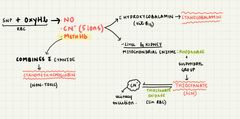
Back (Definition) |
|
|
|
Treatment of Cyanide toxicity |
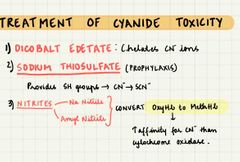
Back (Definition) |
|
|
|
SNP MOA |
Arteriolar + veno dilator D/t NO production Activated enzyme GC ➡️⬆️intracellucar cGMP➡️ calcium influx to the vascular smooth muscle is inhibited➡️⬆️ uptake into smooth ER ➡️ ⬇️cytoplasmic levels➡️ vasodilation |
|
|
|
NTG structure |
Organic nitrate Venodilator only |
|
|
|
Tolerance in NTG |
develops within 48 hours and may be d/t depletion in sulphydryl group within vascular smooth muscle. Tc: Dx free interval for a few hours Infusion of acetylcysteine ( provides SH groups) |
|
|
|
ISDN |
Isosorbide dinitrate is prepared with lactose and mannitol. Metabolites (liver): isosorbide 2 mononitrate and isosorbide 5 mononitrate Used in PX of angina, oral BA: 100% |
|
|
|
Chemical classification of CCB’S |
Class 1:Phenylalkylamines: verapamil Class II: Diphydropyridines: Amlo, nife, nimo Class III: Benzothiazepines diltiazem |
|
|
|
Structure of VERAPAMIL |
Racemic mixture: L isomer: CCB actions (SAN. Avn) D isomer: acts on fast Na channel➡️LA activity |
|
|
|
Metabolism of verapamil |
Demethylation producing nor verapamil |
|
|
|
CCB MOA |
Blocks the L type calcium channels in myocardium, nodal and vascular smooth muscles |
|
|
|
Verapamil composition |
Racemic mixture of L and D isomer L isomer: acts on CCB D isomer acts on sodium channels |
|
|
|
Metabolites of verapamil |
Demethylation to not verapamil |
|
|
|
CCB MOA |
Blocks the L type calcium channels in myocardium, nodal and vascular smooth muscles |
|
|
|
Verapamil composition |
Racemic mixture of L and D isomer L isomer: acts on CCB D isomer acts on sodium channels |
|
|
|
Metabolites of verapamil |
Demethylation to not verapamil |
|
|
|
Hydralazine MOA |
Same as SNP |
|
|
|
Verapamil composition |
Racemic mixture of L and D isomer L isomer: acts on CCB in SAN and AVN D isomer acts on sodium channels |
|
|
|
Diazoxide structure |
Chemically related to thiazide diuretics |
|
|
|
Sildenafil uses |
PAH (20 mg TDS) Erectile dysfunction |
|
|
|
Sildenafil MOA |
cGMP type 5 inhibitor |
|
|
|
Sildenafil metabolism |
Via CYP3A4 |
|
|
|
Bosentan uses |
PAH tc |
|
|
|
Diazoxide MOA |
Increases cAMP in arterioles producing vasodilation Biochemical effects: ⬇️insulin secretions ⬆️catecholamine release |
|
|
|
Bosentan MOA |
Endothelium receptor antagonist at A and B receptor subtypes Decreases systemic and pulmonary vascular resistance W/o rise in heart rate |
|
|
|
Physiology of angiotensinogen breakdown and drugs involved |
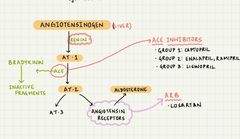
|
|
|
|
Losartan structure |
Substituted imidazole compound |
|
|
|
Losartan MOA |
AT2 receptor antagonist (type AT1) |
|
|
|
CI of ACE and ARB |
Bilateral renal artery stenosis Pregnancy |
|
|
|
Noradrenaline metabolism |
Uptake 1: taken back into nerve terminal, cytoplasm: degraded by MAO UPTAKE 2: non neuronal tissue- degraded by COMT |
|
|
|
Peripherally acting drugs that a block adrenergic neurones |
Guanethidine Metirosine |
|
|
|
Guanethedine MOA |
Triphasic action 1) initial hypotension: d/t direct vasodilation 2) transient HTN: d/t displacement of NA from binding sites 3) hypotension: by preventing release of NA from the nerve terminal |
|
|
|
Drugs that block uptake 1 |
TCA , cocaine Antagonise actions of guanethidine |
|
|
|
Uses of gunethidine |
AntiHTVe agent Chronic pain blocks |
|
|
|
Metirosine |
Competitive inhibitor of tyrosine hydroxylase Used to manage HTN a/W pharochromocytoma |
|
|
|
Centrally acting anti HTVes |
Methyldopa Clonidine Dexmed Atipemazole |
|
|
|
Alpha methyldopa MOA |
Centrally acting alpha 2 agonist Crosses BBB➡️ decarboxylated to alpha methyl NA (alpha 2 agonist) |
|
|
|
Preservative used in alpha methyl dopa |
Sodium metabisulphite |
|
|
|
Clonidine MOA |
Stimulates alpha 2 receptors in the lateral reticular nucleus ➡️reduced central sympathetic outflow SC: augments endogenous opioid release and modulates descending Noradrenergic pathway. Coupled to Gi ➡️⬇️intracellular cAMP |
|
|
|
Effect of clonidine |
Rebound Htn Ceiling effect Diuresis d/t ADH release |
|
|
|
Dexmeditomedine composition |
Racemic mixture D stereoisomer is active |
|
|
|
Atipemazole MOA |
selective alpha 2 antagonist Crosses the BBB reverses sedation and analgesia produced by Clonidine and dexmed |
|
|
|
GABA receptor subtypes |
GABA A GABA B |
|
|
|
GABA a receptor |
Ligand gated Cl Ion channel 5 subunits (alpha, beta delta and gamma) Augments Cl conductance➡️ hyperpolarization Location: postsynaptic |
|
|
|
GABA receptor subtypes |
GABA A GABA B |
|
|
|
GABA a receptor |
Ligand gated Cl Ion channel 5 subunits (alpha, beta delta and gamma) Augments Cl conductance➡️ hyperpolarization Location: postsynaptic |
|
|
|
GABA b receptor |
Metabotropic Acts via GPCR and 2nd msgr. Increases K conductance➡️ hyperpolarization Location: postsynaptically( brain) SC - dorsal horn |
|
|
|
BZD receptors |
GABA a: bind to alpha subunit GABA b: BZ1: SC and cerebellum BZ2: SC, Hippocampus and cerebral cortex |
|
|
|
BZD structure |
2 ring structure Benzene ring: halogen is attached Di- ezepine ring: carbonyl group is attached in position 2 |
|
|
|
Structure of Midazolam |
Depends on surrounding pH Ph < 4: water soluble, closed Di-ezepine ring pH > 4: lipid soluble, open Di-ezepine ring |
|
|
|
Metabolite of midazolam |
By hydroxylation: 2 alpha hydro y Midazolam < 5% oxazepam |
|
|
|
Midazolam and which other Dx is Metabolites by same hepatic enzyme |
Alfentanil by CYP3A3/4 |
|
|
|
BZD with lowest clearance |
Diazepam |
|
|
|
What reduces metabolism of diazepam |
Liver failure Cimetidine |
|
|
|
Flunazenil structure |
Imidazo benzodiazepine |
|
|
|
Flunazenil MOA |
Competitive BZD antagonist |
|
|
|
Z drugs |
NonBZD Hypnotics Zolpidem Zopiclone Zaleplon |
|
|
|
Antidepressants classes |
TCA SSRI MAO I Atyoical agents |
|
|
|
TCA MOA |
Competitively block neuronal uptake of NA and Serotonin Increase NT Concentration in the synapse Block muscatinic, histaminergic and alpha adrenoceptors- nonspecific sedation |
|
|
|
TCA overdose features |
Prolongation of QT &QRS widening (>0.16s) Vent arrhythmias Anticholinergic effects Hyperthermia |
|
|
|
S/e of SSRI |
Inhibit 5HT uptake in platelets➡️ impairs their Dx SEROTONERGIC SYNDROME: Hyperreflexia, agitation, clonus and hyperthermia Eg: with MAOI and SSRI |
|
|
|
Activity of MAO A and MAO B |
MAOA: delaminates 5HT and catecholamines MAOB: deaminates Tyra mine and phenylethylamine |
|
|
|
Name some MAO Inhibitors |
MAO I: phenelzine, isovsrboxazid, tranylcypromine Selective MAO A inhibitors:(RIMA) Moclobemide |
|
|
|
Antibiotic which is aMAO I |
Linezolid |
|
|
|
Mianserin |
Atypical anti depressant MOA: aloha 2 antagonist S/e: agranulocytosis, aplastic anaemia |
|
|
|
Phenytoin uses |
Anticonvulsant Uses: grandmal and partial seizures, trigeminal neuralgia and ventricular arrhythmias following TCA overdose. Normal therapeutic level: 10-20 micrograms/ml |
|
|
|
Phenytoin MOA |
Stabilises inactive sodium channel Reduce calcium entry into neurons and prevents NT release. Enhances action on GABA |
|
|
|
Drug interactions of phenytoin |
Increases metabolism of: warfarin, BZD and OCP It’s metabolism Inhibited by: metronidazole, chloramphenicol and isoniazid Induced by: carbamazepine or alcohol |
|
|
|
Antibiotic that increases the level of carbamazepine |
Erythromycin |
|
|
|
MOA of BZD in status epilepticus |
Enhances chloride gating fx of GABA |
|
|
|
Lamotrigibe MOA |
Inactivation of voltage gated sodium channel on neurones that produce excitatory NT- glutamate and aspartame |
|
|
|
Plasma levels of lithium |
0.5-1.5 mol/L |
|
|
|
Antidiuretic effects |
Lithium Carbamazepine |
|
|
|
MOA of gabapebtin |
Tc of focal seizures Acts on the pre synaptic alpha2 delta subunit of the voltage gated calcium channels in the cortical neurones and increases the synaptic conc of GABA NMDA Antagonist activity |
|
|
|
Vigabatrin |
Complex partial seizure tx Inhibits GABA transaminase |
|
|
|
Pregabalin MOA |
Binds to alpha 2 delta subunit of the cortical neurones. Dosent increase the GABA concentration |
|
|
|
Vasopressin site of production |
Paravebtricular nucleus ( hypothalamus). Transported to the Posterior pituitary |
|
|
|
Vasopressin receptors |
V1a, V1b, V2 GPCR V1a: pulmonary vasodilation Receptors present in renal efferent arterioles compared to afferent arterioles➡️ ⬆️GFR and ⬆️UO |
|
|
|
Metabolism if phenylephrine is via which enzyme |
MAO |
|
|
|
Structure of phenykephrine versus epinephrine |
Structurally similar Phenylephrine lacks hydroxyl group at position 4 on benzene ring |
|
|
|
Atenolol in diabetics |
Can’t be given |
|
|
|
Atenolol in diabetics |
Can’t be given |
|
|
|
Levetirecetam MOa |
Prevents oresynaptic release of calcium |
|
|
|
Sodium valproate MOA |
Sodium channel blockade |
|
|
|
Effects of salbutamol |
Beta effects: raised blood sugars and FFA LACTIC ACIDOSIS: ⬆️glycogenolysis and lipolysis ( type B lactic acidosis) Crosses placenta: produces tachycardia |
|
|
|
Effects of magnesium |
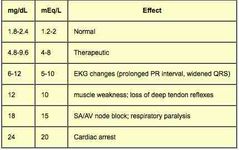
Back (Definition) |
|
|
|
Steroids and beta 2 agonists in the treatment of asthma |
Steroids reduce the requirement of beta 2agonists in asthma |
|
|
|
Dose of IV aminophylline |
LD: 5mg/kg over 20 mins MD: Infusion of 0.5-0.7 mg/kg/h |
|
|
|
Magnesium sulphate dose for acute asthma |
2g (8k mol) over 20 mins |
|
|
|
Carbocisteine |
Mucoactive agent: anti inflammatory and antioxidant properties Avoided in active gastric ulceration Good penetration of lung tissue and bronchial secretions |
|
|
|
Erythromycin MOA |
Macrolide antibiotic Lower doses: prokinetic Direct motilin agonist |
|
|
|
A/e of erythromycin |
Ecg changes: prolongs QT interval, dysrhythmias - torsades de pointes CYP3A4 inhibitor- enhances action of warfarin |
|
|
|
Metoclopramide MOA |
Centrally and peripherally acting D2 antagonist Central effects: 5HT antagonism with dopamine antagonism Antiemetic effect and neuroleptic effects➡️ dyskinesias and oculigyric crisis Peripheral effects: enhances gastric motility via cholinergic and D2 effects. |
|
|
|
H2 receptor antagonist examples |
Ranitidine Cemetidine |
|
|
|
Docusate MOA |
Stimulant for peristalsis |
|
|
|
Recommendation of oxytocin in pregnancy |
ALL WOMEN should be given 5IU oxytocin to improve uterine contraction and decrease risk of PPH |
|
|
|
Synthetic form of oxytocin |
SYNTOCINON™️ |
|
|
|
Ergometrine CI |
Second line uterotonic. CI: pre eclampsia, eclampsia, severe HTN or cardiac disease Caution in mild HTN |
|
|
|
Ergometrine ( syntometrine) Dose |
500 mcg IM |
|
|
|
Carboptost aka |
Synthetic analogue of PGF2alpha. Caution in asthmatics Uses: to control PPH unresponsive to other methods |
|
|
|
Misoprostol |
Synthetic analogue of PGE1 Pessary to induce labour |
|
|
|
Oxytocin antagonist |
ATOSIBAN |
|
|
|
Tocolytics available |
Beta 2 agonists: ritodrine, terbutaline and salbutamol Emergency uterine contraction: sublingual NTG, sc terbutaline Magnesium sulphate PG synthetase inhibitors: NSAIDS: Indomethacin, ketorolac |
|
|
|
Alternatives to ritodrine ( no longer manufactured) |
Nifedipine and atosiban |
|
|
|
Antifungal agents |
POLYENES: Amphotericin B AZOLES: a) imidazoles eg; ketoconazole b) triazoles: eg; fluconazole and posaconazole |
|
|
|
Amphotericin B MOA |
Wide spectrum: candida, aspergillus and cryptococcus Reacts with ergosterol (fungal cell wall) |
|
|
|
Amphotericin B A/e |
Nephrotoxic Gi disturbances, anaphylaxis, convulsions Deranged LFT |
|
|
|
Azoles MOA |
Inhibiting biosynthesis if ergosterol |
|
|
|
Posaconazole |
Oral suspension only Broad spectrum Antifungal |
|
|
|
AzolesA/e |
Hepatic dysfunction |
|
|
|
Bactericides agents |
Bactericidal antibiotics: remember of "BANG Q R.I.P." Beta-lactams Aminoglicosides ( gentamicin, tobramycin, amikacin) Nitroimidazoles (metronidazole) Glycopeptides (vancomycin) Quinolones Rifampicin Polymyxins (colistin) |
GP MAC |
|
|
Bacteriostatic |
MS COLT Macrolides: erythromycin, clarithromycin, azithromycin, fidaxomicin and telithromycin Sulfonamides Chloramphenicol Oxazolidinones Lincosamides (clindamycin) Tetracyclines |
|
|
|
Mechanisms for resistance in micro organisms |
Genetic mutation Gene transfer |
|
|
|
Ways of genetic transfer |
Transformation: dna released and taken up Transduction: via bacteriophages Conjugation: cell to cell contact directly Transposons: small segments that encode resistance |
|
|
|
Misuse of cephalosporins and quinolones produce virulent strains of which bacteria |
Clostridium difficile |
|
|
|
Vancomycin MOA |
Glycopeptide, inhibits cell wall synthesis |
|
|
|
Vancomycin a/e |
Red man syndrome Histamine release causes tachy, hypotension and widespread rash |
|
|
|
Vancomycin MOA |
Glycopeptide, inhibits cell wall synthesis |
|
|
|
Beta lactam antibiotics |
Penicillins Cephalosporins Monobactams Carbapenams |
|
|
|
Metronidazole MOA |
Inhibits DNA synthesis |
|
|
|
How is human insulin metabolised |
Glutathione insulin transhydrogenase |
|
|
|
A/e of thiazolidinediones |
Water retention Avoided in CCF patients |
|
|
|
Carbomazole MOA |
Active metabolite: thiamazole Actions: inhibits iodinating if tyrosyl residues in throglobulin Inhibits coupling of iodotyrosines |
|
|
|
S/e of carbimazole |
Maculopapular rash Myopathy: monitor CPK levels BM depression: fatal agrunocytosis Abnormal LFT: Discontinue carbimazole Angioedema and type 3 HS Rxn. |
|
|
|
Equivalence of 5 mg orednisolone |
Betamethasone 750 mcg Dexa: 750 mcg Hydrocortisone: 20 mg Methylprednisolone: 4mg Triancinalone: 4 mg |
|
|
|
Caffeine MOA |
Inhibits phosphodiesterase Central adenosine receptor antagonism |
|
|
|
Doxapram indications |
Peripherally and centrally acting respiratory stimulant Tx of post op respiratory depression, acute respiratory failure and neonatal apnoea Increases rate and depth of respiration |
|
|
|
Metabolites of doxapram |
2- kerodoxapram |
|
|
|
How is doxapram prepared |
In 0.9% benzylalcohol |
|
|
|
doxapram preservative |
0.9% benzylalcohol R/o metabolic acidosis and kernicterus in neonates |
|
|
|
How is wernickes encephalopathy produced |
VIT b1 defeciency in chronic alcoholics |
|
|
|
Ethanol (alcohol) enhances responses at which receptor |
GABA A Serotonin and glycine Antagonist at: NMDA |
|
|
|
Paracetamol merabolites |
Site: Liver Metabolites: glucuronude, sulphate and cysteine conjugated |
|
|
|
Boiling Points of a) Diethyl ether b) cyclopropane c) n2O d) Halothane e) Trichloroethylene |
a) Diethyl ether: 35C b) cyclopropane: -33 C c) n2O: -88 C d) Halothane: -50.2C e) Trichloroethylene: 87C |
|
|
|
Process of metabolism of morphine |
Site: Liver Phase1: oxidative N dealkylation Phase2: conjugation with glucuronide ➡️ hydrolysed in the GIT➡️morphine is re absorbed |
|
|
|
MAO inhibitors |
MAO A: preference for5HT MAO B: preference for phenylethylamine Both: preference for NA and Dopamine MAOI: Increase level of 5HT, NA,Dopamine in the body. |
|
|
|
S/e of MAOI |
Postural hypotension ⬆️CNS Stimulation: tremors, excitement , insomnia, convulsions Weight gain Atropine like s/e S/e with PETHIDINE: hyprerpyrexia, htn and coma |
|
|
|
Metabolism of bupivacaine |
N dealkylation 16% excreted unchanged in urine |
|
|
|
Ritodrine MOA |
Beta 2 agonist Relaxes uterine smooth muscle Uses: delay delivery in premature labour |
|
|
|
Temazepam site of action |
Temazepam is 1,4 BZD site; BDZ 1-3 |
|
|
|
Conditions that reduce plasma cholinesterase activity |
Pregnancy Liver disease Cardiac and renal failure Burns |
|
|
|
Drugs that reduce plasma cholinesterase activity |
Ecothiopate,tacrine, lidocaine, procaine, lithium, mg, ketamine, pancuronium, OCP and cytotoxic agents |
|
|
|
Conditions that reduce plasma cholinesterase activity |
Pregnancy Liver disease Cardiac and renal failure Burns |
|
|
|
Neuroleptanalgesia |
Butyrophenone in conjunction with a potent opioid |
|
|
|
Meptazainol |
Opioid agonist |
|
|
|
Metabolism of atracurium |
Hoffmann elimination Ester hydrolysis |
|
|
|
Does mgso4 produce diahorrea |
Yes. Orally administered |
|
|
|
Drug which alters its structure according to pH |
Midazolam Open ring at ph3-water soluble Closed ring at ph>4- lipid soluble |
|
|
|
Action of ketamine on uterus |
Increases the uterine tone |
|
|
|
Factors prolonging the action of NDMR |
Hypermagnesemia Acidosis Hypercapnia Drugs: VA, Such, calcium antagonists, protamine, fentanyl, alpha and beta blockers, metronidazole, aninoglycosides |
|
|
|
Dx causing methhemoglobinemia |
Prilocaine Chlorate Quinones Nitrates Sulphonamides |
|
|
|
Droperidol MOA |
Butyrophenone derivative D2 receptor antagonist at CTZ postsynaptic GABA antagonist Alpha1 antagonistic pptys: minor |
|
|
|
Ergotamine |
Ergot alkaloid acting at HT1 receptor Used in the treatment of migraine |
|
|
|
Cimetidine MOA |
H2 receptor antagonist Antiandrogenic effects: gynaecomastia and impotence |
|
|
|
Midazolam produces which type of amnesia |
Anterograde |
|
|
|
Factors affecting BA |
Gastric pH Enzyme activity in the GIT Intestinal motility First pass metabolism |
|
|
|
Metabolic disorder produced by a) loop diuretics and thiazide diuretics b) CA inhibitors |
a) hypokalemic hypochloremic metabolic alkalosis b) metabolic acidosis |
|
|
|
Drugs affecting gastric emptying |
Metoclopramide Antimuscaranics Opioids |
|
|
|
Properties of inhalationals |

|
|
|
|
Physical properties of oxygen |
Boiling point: -182C Critical temp: -119C Critical pressure: 50 bar Melting point: -218C Atomic weight: 16 Molecular weight: 32 |
|
|
|
Storage of oxygen |
Gas: black cylinder with white shoulders: 137 bar Liquid: VIE: 10 bar and -180C |
|
|
|
Classification of dopamine antagonists |
Phenothiazines: eg- chlorpromazine, prochlorperazine Butyrophenone eg- domperidone, droperidol Benzamides eg: Metoclopramide |
|
|
|
Chlorpromazine MOA |
D2 receptor antagonist H1, alpha 1, alpha2 and 5HT3 receptor antagonist |
|
|
|
Nk1 receptor antagonist and MOA |
Fosprepitant Antiemetic Blocks substance P in the brain stem |
|
|
|
H1 receptor antagonist H2 receptor antagonist 5HT3 receptor antagonist |
H1 receptor antagonist: CYCLIZINE H2 receptor antagonist: Ranitidine, cimetidine 5HT3 receptor antagonist: ondansetron, granisetron |
|
|
|
Syntometrine |
Ergotometrine 500 mcg+ oxytocin 5IU |
|
|
|
Uterotonic drugs |
Oxytocin Ergot alkaloids PG: PGE2, PGF2alpha, PGE1analogue- misoprostol |
|
|
|
Tocolytic drugs |
Beta agonists: ritodrine, salbutamol and terbutaline CCB: nifedipine Oxytocin antagonists: atosiban Others: MgSO4, PG synthetase inhibitors( eg: indomethacin), NTG |
|
|
|
Drugs metabolised by plasma cholinesterase |
Ach Such Mucacurium Ester LA Diamorphibe Aspirin Prapandid |
|
|
|
Pirenzepine |
Selective M1receptor antagonist |
|
|
|
Composition of Hartman’s solution |
131 mmol/l sodium 111 mmol/l chloride 2 mmol/l calcium 5 mmol/l potassium 29 mmol/l lactate |
|
|
|
Carbimazole MOA |
Inhibits thyroid peroxidase Prevents iodide to iodine Prevents synthesis of T3 and T4 |
|
|
|
Propylthiouracil |
Blocks iodinating of tyrosine Blocks conversion of aT4 to T3 |
|
|
|
Colloid types |
a) 4.5% or 20% albumin b) HES: 90% amylopectin etherified with Hydroxyethyl groups. c) Gelatin: gelofusine, haemaccel d) Dextrans |
|
|
|
Crystalloid sand compositions |

Back (Definition) |
|
|
|
Ach antagonists |
Benzhexol Benztropine Orphenadrine Procyclidine |
|
|
|
Antiparkinsonian drugs |
Levodopa; D2 agonist Carbodopa/ benserazide: inhibits dopa decarboxylase peripherally Domperidone: dopamine antagonist Bromicriptone: D2 agonist Ach antagonists: see before Decrease central cholinergic activity |
|
|
|
Respiratory stimulants |
Doxapram: action on peripheral chemoreceptor. ⬆️TV> RR Aminophylline: PDE bronchodilator drug Theophylline + ethylenediamine |
|
|
|
Classification of isomerism |
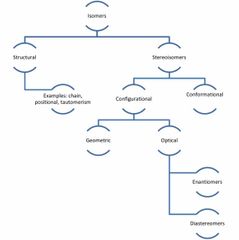
Back (Definition) |
|
|
|
Facilitated diffision |
Glucose ( via GLUT 4) Cephalexin Azoles |
|
|
|
Active transport |
Sodium and potassium via Na/K ATPase 5 Flurouracil |
|
|
|
DRG diagrams |
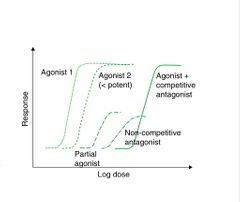
Back (Definition) |
|
|
|
Molecular weight of inhalationals |
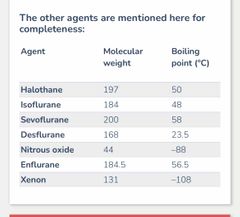
|
|
|
|
INTRA lipid constituents |
20% soya bean oil 1.2% egg phosphatides 2.24% glycerine Water |
|
|
|
Effect of NSAIDS on bone healing |
Inhibit the osteoblast function and delay wound healing |
|
|
|
Selective COX2 inhibitor with a decreased GI side effect profile |
Meloxicam |
|
|
|
Selective COX 2 inhibitor to be avoided in sulphonamide allergy or porphyria |
CELECOXIB |
|
|
|
8 hour recommended regulations for gases in UK |
N2O: 100 ppm Sevo: 20 ppm Enflurane, iso, des: 50 ppm Halothane: 10 ppm |
|
|
|
Ethosuximide |
Blocks the thalamicT type calcium channels |
|
|
|
Hydrocortisone dose in pediatric |
4mg/kg |
|

